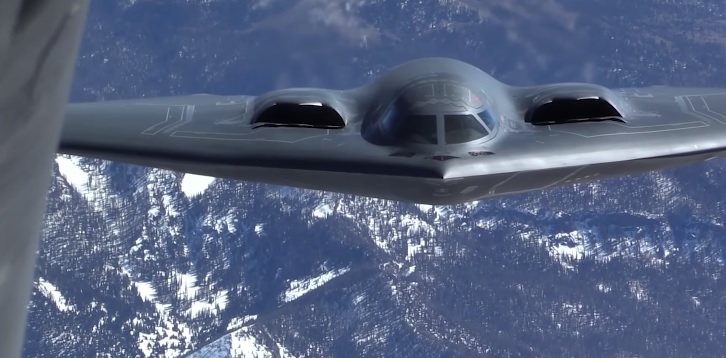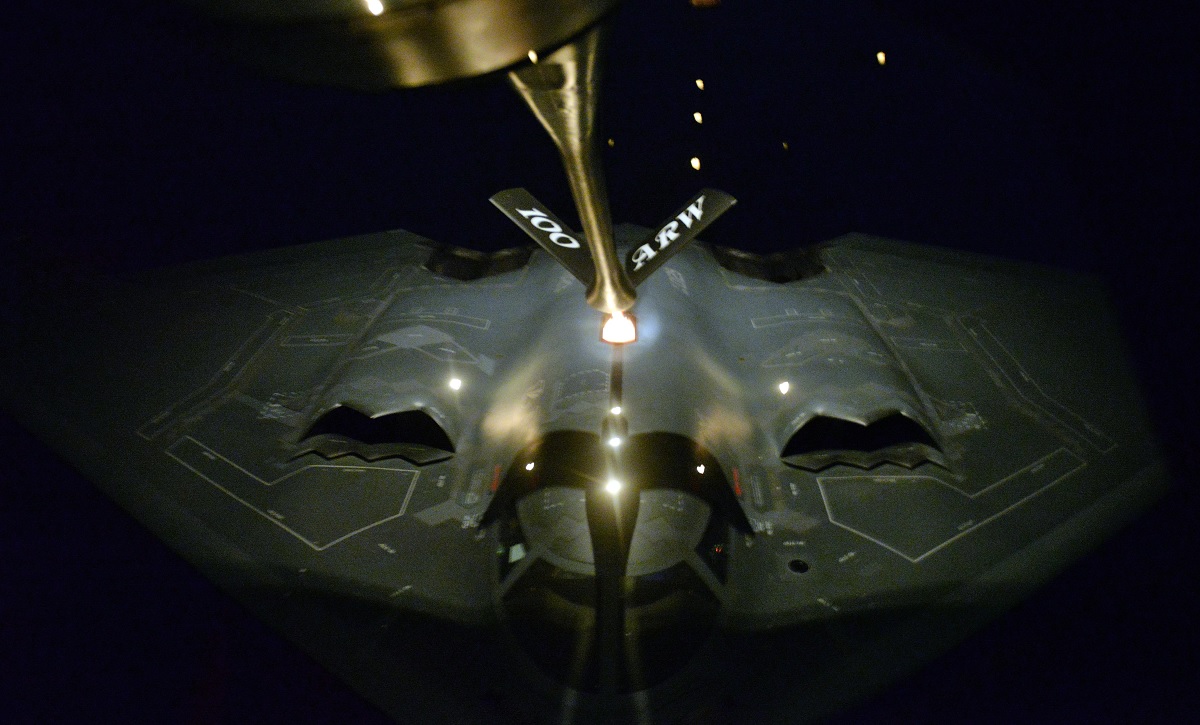The weather conditions were poor due to a nearby storm, but the KC-135 crew was able to extend the boom and make contact with the B-2 Spirit stealth bomber
A KC-135 Stratotanker aircraft crew from the 171st Air Refueling Wing responded to an urgent request for fuel from a B-2 bomber on Oct. 25, 2022, Alert 5 first reported.
As told by Senior Master Sgt. Shawn Monk, 171st Air Refueling Wing, in the article 171st Tanker Keeps Low-on-Fuel Stealth Bomber Airborne, the KC-135, an aircraft capable of air refueling, call sign “Steel 51”, was performing its preflight checklist. The three-man crew began to start the engines and prepared to depart from Tinker Air Force Base, Oklahoma City, to fly to their home base, the 171st Air Refueling Wing, an Air National Guard base near Pittsburgh. The crew was returning the aircraft after it completed regular scheduled maintenance.
Just before takeoff, with the first of four engines started, Steel 51 received an unexpected call requesting immediate refueling for a B-2 Spirit stealth bomber. The B-2, call sign “Fury 72,” was quickly running low on fuel had about 90 minutes remaining.

Moments before that call, Tech. Sgt. Scott Nagel, a boom operator with the 171st, received the initial request from Whiteman AFB. Nagel said that it’s normal to get calls for fuel throughout the week, but normally refueling missions are scheduled weeks in advance for routine operations and training. In this case, when he asked when they wanted to schedule, the response was “We need it right now.”
Realizing the urgency of the situation, Nagel relayed the message to the duty officers, Capt. Seth Melnick and Lt. Col. Erik Schillo, who were just about to change shifts for the day. Learning about the situation, they quickly scrambled to coordinate with Tinker AFB, Whiteman AFB, and the crew of Steel 51.
Steel 51’s crew, pilots Maj. Dan Dynys, and Capt. Bryant Laris, and boom operator Master Sgt. Mike Worthington only had enough fuel to fly to Pittsburgh as the aircraft was not scheduled for an air refueling mission. But Steel 51 was the only tanker ready and within range that could help.
“We only had enough gas to make the flight home, but Capt. Melnick asked how much extra we might have to give to a receiver and how soon we could take off,” said Laris. “He informed me that the receiver would be able to meet us on our planned route of flight, so we agreed to take off as soon as possible and figured the rest out in the air since time was critical for the receiver.”

Steel 51 took to the sky and flew to rendezvous with Fury 72.
The plan was made enroute. Steel 51 would give the B-2 as much fuel as they could while leaving enough to circle back to land at Tinker AFB.
“Once we were airborne, we flew as fast as we could to try and meet the receiver,” said Laris. “Everyone on our crew was working hard to expedite the rendezvous with the receiver, coordinate a random air refueling with Air Traffic Control, and calling Air Force bases in the area to coordinate a divert if it would be necessary.”
Fury 72, a stealth bomber aircraft capable of delivering nuclear weapons, was originally scheduled to land at Whiteman AFB, Missouri, after a long-range test mission. Due to a sudden and unexpected runway closure, Fury 72 had no place to land and was circling above Whiteman AFB until the runway could be re-opened. Diverting the stealth bomber to another air base was an option, but as a last resort. Unlike a civilian passenger airliner, diverting a technologically advanced stealth bomber requires extensive coordination and time. Air refueling would prevent the need to divert.

Roughly 45 minutes after Nagel received the initial call, Steel 51 and Fury 72 began lining up for air refueling procedures. The weather conditions and visibility were poor due to a nearby storm. Master Sgt. Mike Worthington, the Boom Operator on Steel 51, saw the silhouette of the stealth bomber approaching through the clouds and guided the twenty-foot boom into position with special controls from his position at the tail end of the aircraft.
The stealth held its position about 20 feet below the 63-year-old tanker. Through the turbulence and low visibility, Worthington skillfully extended the boom and made contact with the B-2 and offloaded 17,500 pounds of fuel, allowing Fury 72 to stay airborne long enough for the runway at Whiteman AFB to be cleared for landing.
“Overall we were very lucky to be in a position to assist,” said Laris. “All the members of our crew and the crew of Fury worked expeditiously to overcome a real world, time critical, air refueling mission that was made very challenging with adverse weather and minimal planning time available.”
Steel 51 circled back to Tinker AFB and landed. The ground crew at Tinker AFB was aware of the situation and provided fuel to Steel 51 so it could continue on its way to Pittsburgh the same day.
The KC-135 Stratotanker provides the core aerial refueling capability for the US Air Force and has excelled in this role for more than 60 years. This unique asset enhances the Air Force’s capability to accomplish its primary mission of global reach. It also provides aerial refueling support to Air Force, Navy, Marine Corps and allied nation aircraft. The KC-135 is also capable of transporting litter and ambulatory patients using patient support pallets during aeromedical evacuations.
Air Mobility Command manages an inventory of 396 Stratotankers, of which the Air Force Reserve and Air National Guard fly 243 aircraft in support of AMC’s mission.
The KC-135R and KC-135T aircraft continue to undergo life-cycle upgrades to expand their capabilities and improve reliability. Among these are improved communications, navigation, autopilot and surveillance equipment to meet future civil air traffic control needs.
Photo by Tech. Sgt. Matthew Plew Senior Master Sgt. Rose Reynolds / U.S. Air Force

